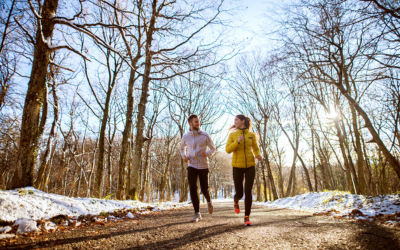10 Tips for Running in the Cold
When the temperature starts to drop, don't let your motivation for exercise fall along with it. Cold weather doesn't have to put a freeze on your outdoor running. If you're careful, you can still get in all your steps by following these 10 cold-weather running safety tips.

- Don’t skip the warm up. Warming up before exercising is always important, but even more so when it gets cold.
- Check conditions. Always check your local weather source for running conditions before you head out. Wind chill increases the rate at which heat is carried away from the body. The faster the wind, the faster the body's temperature is driven down.
- Get the right shoes. The American College of Sports Medicine warns that running shoes that are too tight can decrease blood flow and increase cold injury risk. Getting the right fit is key. Your cold-weather running shoes should also be made of a durable material, waterproof to keep your feet warm, and have reliable traction to avoid slips and falls.
- Stay visible. With shorter daylight hours in the fall and winter, it’s important to stay visible with high visibility running gear, such as headlamps, reflective clothing and safety lights.
- Wear the right materials. Clothing is critical. Although a double-thick cotton sweatshirt may seem like a good choice, it doesn't insulate nearly as well as synthetic fabrics like lightweight polyester, polypropylene or moisture-wicking materials.
- Don't overdress. You can overheat even in below-freezing temperatures. If you dress too warmly, you'll sweat a lot. Then, when cold winds hit, perspiration will rapidly evaporate, chilling you. You want to limit perspiration and keep it away from both your skin and the outside air.
- Layering is key. Wear a synthetic material against your skin. This will let the sweat pass through the fabric away from your body. The second layer should be wool, polyester or fleece for primary insulation. The third layer should be chosen for its ability to keep out the cold air, wind and rain. This layer should be something lightweight and synthetic. Layering also helps regulate your temperature. If you get too warm, you can strip off a layer.
- Protect your head, feet and fingers. You can lose a tremendous amount of heat through your uncovered head, so wear a hat, cap or hood. Your feet get cold first. Wear warm, waterproof boots or shoes. Insulate them with warm socks and keep them dry. Because of the large surface area to volume, your hands are also more susceptible to cold. Gloves or mittens should be worn before the hands become cold.
- Stay hydrated. If you can see your breath, you're seeing moisture leave your body. So drink plenty of fluids, particularly if the air is cold and dry. Drink water before you go out and bring some with you. Don't drink alcohol. Alcohol actually makes you lose heat.
- Don't overdo it. Cold is a stress on the body and so is exercise. Together, they may be too much for someone not in the best of health. Talk to your healthcare provider before you start a winter exercise program. Older adults and people who take certain medicines or who have diabetes are at greater risk of their body temperature dropping in cold weather. If you experience spine or joint pains when running, you may want to consider getting a professional assessment. A professional running assessment can be a great option for runners looking to prevent overuse injuries, reduce pain or improve form.
Any person with spine or joint pains related to biking or running can benefit from a professional assessment. Our licensed PTs aim to set patients up for success to reduce pain and prevent future injury. Overlake Clinics Musculoskeletal Medicine provides comprehensive diagnostic and treatment options.









